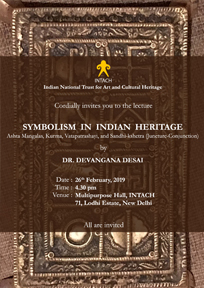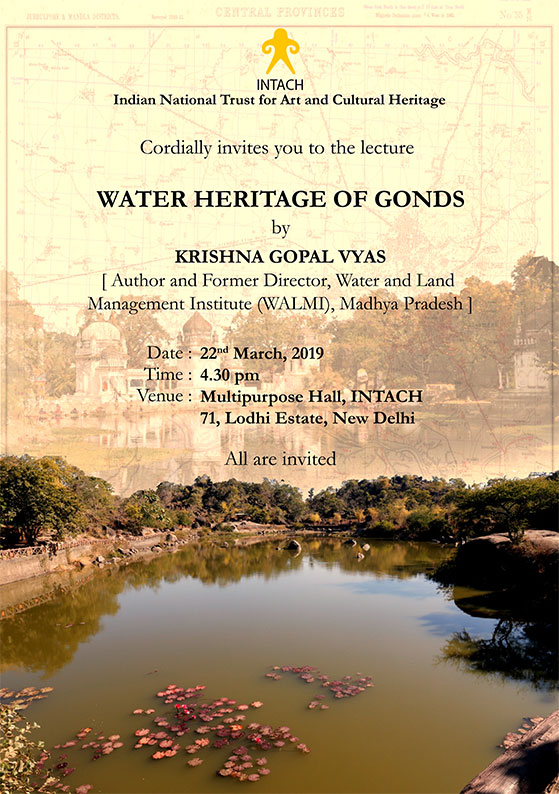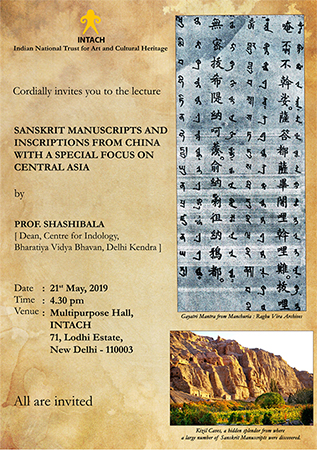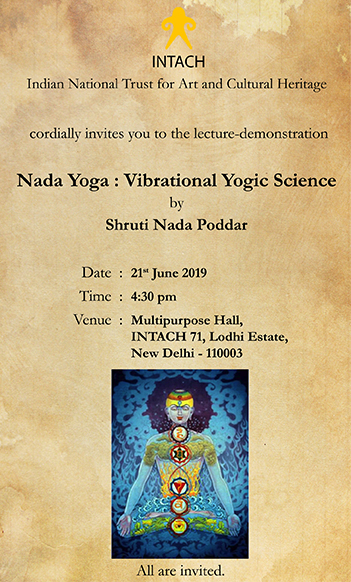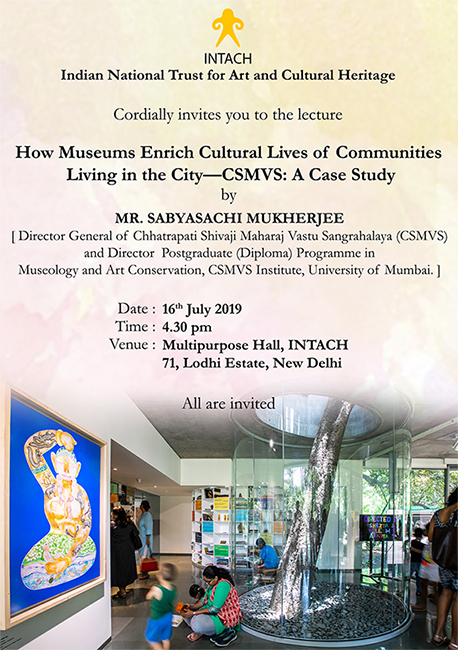Events Archives
-
Lecture on ‘Symbolism in Indian Heritage’ by Dr. Devangana Desai
Date: 26th February 2019
Time: 4.30 pm
Location: Multipurpose Hall, INTACH, New DelhiIt gives us great pleasure to invite you to the lecture – Symbolism in Indian Heritage: Ashta Mangalas, Kurma, Vatapatrashayi, and Sandhi-kshetra (Juncture-Conjunction) at INTACH.
Dr. Desai will speak on the different philosophies and meanings as represented by Ashta Mangalas – the eight auspicious symbols which differ in meanings in Buddhism, Hinduism and in Shvetambara and Digambara sects of Jainism. Kurma (tortoise, turtle) – as a symbol of self-control in the Bhagavad Gita and other texts and its association with water cosmology. Vatapatrashayi – Krishna on a banyan leaf floating on the cosmic ocean. Symbolically, it represents the first form of life on Earth. Sandhikshetra – Juncture-Conjunction – In the integrated temples of Khajuraho (10th -11th centuries) erotic figures were placed by architects on the juncture (sandhi-kshetra) of the sanctum and the hall. This is noticeable on the sandhara temples (with inner circumambulation) where two equal squares of the sanctum and the hall overlap.
Dr. Devangana Desai is an art historian. She is a Trustee of the Chhatrapati Shivaji Maharaj Vastu Sangrahalaya (Formerly Prince of Wales Museum of Western India), Mumbai, and the Sarabhai Foundation (Calico Museum), Ahmedabad.
Dr. Desai was the Vice-President of the Asiatic Society of Mumbai until 2015 and the Editor, Journal of the Asiatic Society of Mumbai, for seventeen years from 1992 to 2009. She served as the Chairperson of the Museum Society of Bombay from 1983 to 1992.
She is the author of – Art and Icon – Essays on Early Indian Art, Khajuraho – Monumental Legacy, The Religious Imagery of Khajuraho, Erotic Sculpture of India – A Socio-Cultural Study Sectional presidential address, Indian History Congress (1989), titled Social Dimensions of Art in Early India; and presidential address for Indian Art History Congress (2013) titled Art and Literature – A Dialogue. She has written over a hundred papers on various aspects of Ancient Indian Art.
Dr. Desai was awarded the Homi Bhabha Fellowship – 1978-80, and the Dadabhai Naoroji Memorial Prize 1983.In 2015 she was the recipient of the Hirayama Prize from Institute de France, Paris, for “the totality of researches in the field of Indian Art”. Dr. Desai has lectured extensively all over the world.
She is the Series Editor for the Monumental Legacy Series on the World Heritage Sites in India, Oxford University Press, New Delhi.
Dr. Desai sponsored the renovation of the Sculpture Gallery of the Chhatrapati Shivaji Maharaj Vastu Sangrahalaya, Mumbai. In 2017, she instituted the ‘Dr. Devangana Desai Endowment Programme’ at the Sangrahalaya, which promotes fellowships and arranges lectures by eminent scholars.
-
Lecture on ‘Water Heritage of Gonds’ by Shri Krishna Gopal Vyas
Date: 22nd March 2019
Time: 4.30 pm
Location: Multipurpose Hall, INTACH, New DelhiIt gives us great pleasure to invite you to the lecture at INTACH. Shri K. G. Vyas will talk about the water tanks and step-wells which Gonds of Garha-Mandla (1300-1789), constructed during their rule. They constructed 52 moderate to large tanks and 161 small tanks (Tallaiya) and a few step-wells in and around Jabalpur, Madhya Pradesh. In the past 500 years, these water bodies have suffered from neglect and encroachment. Luckily, a few of them survive and are still in good condition.
The shape and size of these tanks is controlled by the local topography and demonstrate an intimate relationship with the local geological formations. An analysis shows that fifty-five per cent of the tanks have been constructed on alluvium formation, twenty-seven per cent tanks on weathered granite, thirteen per cent on porous and permeable sandstone and only two per cent tanks are constructed on lamets formation whereas step-wells are located only on weathered granite. This distribution clearly indicates that the Gonds had a very clear understanding of the water-bearing properties of different geological formations.
These tanks have ensured water availability to the area even in the worst summer season. Their technical superiority lies in the fact that these tanks are almost silt free. The inflow and outflow of water is balanced in a way that very little silt gets accumulated in them. These tanks and step-well exhibit technical water wisdom of Gonds of Central India.
Mr K. G. Vyas is a former Director, Water and Land Management Institute, (WALMI), MP.
He taught Geology in various colleges of Madhya Pradesh for twelve years after which he joined the State Irrigation Department. He headed the groundwater survey wing of the Irrigation Department, MP from 1992 to 1994. During this period, he was associated with the World Bank aided hydrology project.
Shri Vyas studied Natural Resource Management in Australia in the year 2000. Upon his return, he developed the concept of Jal Swaraj (Universal Availability of Water). Based on this concept, the Government of MP has run Pani Roko Abhiyan in the state. In 2018, Shri Vyas developed the River Revival Manual.
He has authored fourteen books and more than a hundred articles and research papers on water and related subjects for various magazines, newspapers and journals.
Shri Vyas is the recipient of many awards and honours.
-
The Eleventh Pupul Jayakar Memorial Lecture
‘Haṃpi, Virupaksa, Hosapattana – Vijayanagara’ by Dr. Vasundhara Kavali-FilliozatDate: 18th April 2019
Time: 6.15 pm
Location: Multipurpose Hall, India International Centre, Max Mueller Marg, New DelhiIt gives us great pleasure to invite you to the lecture on Haṃpi, Virūpākṣa, Hosapaṭṭaṇa; these different names are of one and the same place – Vijayanagara. This small but extremely holy centre to Śivaïtes enjoyed the status of a pilgrim centre, royal camps, secondary capital and then in the first half of the 14th century a full-fledged capital, shining with glory, wealth and so on. The fame of the capital was heard beyond the eastern and western oceans. Following a battle with Shahi Sultans of Deccan such a splendid capital and the empire fell in the “oubliette” of human memory. It survived as best as it could from the hands of vandals, treasure-seekers, wild animals and reptiles till the end of the 19th century when Archaeological Survey of India took the Hampi monuments for protection. There are more than five hundred edifices spread over 30 sq. kms., rendering the site of Haṃpi-Vijayanagara fascinating.
Vasundhara Filliozat, is a historian of art and an epigraphist. She works alternatively in India to explore the archaeological and literary past of her country and in France to encourage knowledge and appreciation of culture and civilization of India in general and Karnataka in particular. Her works have been acknowledged and honoured with an award by the Government of Karnataka in 2003. In 2004, she was honoured by the Vasundhara Performing Arts Centre Trust for her outstanding contribution in the field of Arts, Culture and Literature. She was elected President of the 22nd Congress of the Karnataka History Academy in 2008. Since 2012 she has been organizing a Sanskrit Day in Paris in collaboration with the Maison de l’Inde under the patronage of the Indian Embassy in Paris.
She has authored more than twenty-six books and numerous articles in Kannada, English and French including Vijayanagar Chronicles from 1520 to 1880; National Book Trust, Delhi. This book is prescribed as one of the source books by the University of Delhi for the Medieval Indian History of India
She travels around the world for lectures and seminars.
-
Lecture on “Sanskrit Manuscripts and Inscriptions from China with a Special Focus on Central Asia” by Prof. Shashibala
Date: 21st May 2019
Time: 04: 30 pm
Location: Multipurpose Hall, INTACH, New DelhiIt gives us great pleasure to invite you to the lecture at INTACH. Prof. Shashibala will talk about the Sanskrit Buddhist texts which played a key role in transmitting the knowledge from India to China and other Asian countries. From the 1st century onwards hundreds of monks travelling via Silk and Marine routes carried, copied and translated them at the monasteries. Today they are preserved in a number of collections all over the world. A no man’s land of Central Asia became the most important cultural repository around the end of the 19th century with the discovery of the manuscripts and other cultural relics. They include cloth, paper, palm-leaf or birch-bark manuscripts, wooden tablets and inscriptions. These were discovered and preserved by the Germans, French, Japanese, Russians, British and Indians. The texts are often on Vinaya, Abhidharma, Jatakas, Avadanas, Stotras, Agamas, Sutras, grammar, medicine, yoga, and other sciences.
Prof. Dr. Shashibala, Dean, Centre for Indology, Bharatiya Vidya Bhavan, Delhi Kendra, specializes in Buddhist arts and cross cultural connections among Asian countries. She has 19 publications to her credit; 63 research papers, 15 years of teaching at the National Museum Institute, 45 years of research experience, exploring, documenting and travelling widely and organizing international conferences and exhibitions and delivering illustrated lectures.
-
Lecture demonstration on ‘Nada Yoga: Vibrational Yogic Science’ by Dr. Shruti Nada Poddar
Date: 21st June 2019
Time: 04: 30 pm
Location: Multipurpose Hall, INTACH, New DelhiIt gives us great pleasure to inform you that on popular demand we are organizing the lec-dem and interactive session on ‘Nada Yoga’ by Dr. Poddar.
Nada is the body of vibrations, waves, frequencies and harmonies within everything that exists. It is experienced by us and influences us at all times, often unknown to us. Nada Yoga which has been used in almost every Indic spiritual and wellness practice through time offers powerful Nada (vibrational) techniques and remedies. The experiential talk and lec-dem on Nada Yoga on International Yoga day will highlight and teach the audience some tools for self-healing.
Dr. Shruti Nada Poddar is a pioneer of the NADA VIBRONICS – a Nada Yogic Wellness Ecosystem based on Indic Vibrational Yogic Science. She has taught and influenced teachers worldwide in integral education and indigenous knowledge systems. She regularly gives talks and conducts workshops on various subjects and Indic technologies ranging from leadership through Vedas, Upanishads and the Bhagawadgita to conservation of heritage as well as scientific explorations of music and ancient Indian sound and the extensive ecosystem of Nada or the vibrational realm for cure of diseases, wellbeing and empowerment.
Shruti Poddar founded the Shruti Foundation in 2007, a research and charitable foundation for promoting heritage, cultural exploration, integral education, wellness and healthcare as well as value-based leadership and advocacy with a special focus on indigenous knowledge systems and sciences. Her focus is now at the grassroots for conservation of intangible and intangible heritage and empowerment of women and youth with indigenous knowledge, local expertise and cultural empowerment.
Dr. Shruti Poddar is the Convener of INTACH for three districts of Rajasthan, Sikar, Churu and Jhunjhunu. She is also a member of INTACH advisory board for Intangible Cultural Heritage.
-
Lecture on ‘How Museums Enrich Cultural Lives of Communities Living in the City-CSMVS: A Case Study’ by Mr. Sabyasachi Mukherjee
Date: 16th July 2019
Time: 4.30 pm
Location: Multipurpose Hall, INTACH, New DelhiIt gives us great pleasure to invite you to the lecture at INTACH. A museum as an institution holds an important place in society as it tells the story of man and his relation to the world. As a cultural and a social space it is also a meeting space for communities to engage in dialogue and exchange of ideas. At a time when art has become increasingly popular with broad based community recognition, and museum activities are on the rise in South and South-east Asia, it is opportune to create a constructive criticality around the idea of the museum – what are the opportunities for collection formation? What kind of exhibitions create new thinking about art history that reflects current experiences? How do we activate the museum/cultural spaces for different communities living in the city?
The presentation raises questions and enumerates the role of museums and its connection with different communities living in the city and by providing examples of community participation.
Mr. Sabyasachi Mukherjee is Director General of Chhatrapati Shivaji Maharaj Vastu Sangrahalaya (CSMVS) and also Director of the Postgraduate (Diploma) Programme in Museology and Art Conservation at CSMVS Institute, University of Mumbai. Under his leadership from 2007, CSMVS has undergone extensive modernization including refurbishment of the museum’s main building and the establishment of a conservation centre, a new Children’s Museum, an institutional archive, new galleries and educational initiatives. In 2010, in recognition of his initiatives, UNESCO awarded the museum the 2010 Asia-Pacific Heritage Award for Cultural Heritage Conservation. Mr. Mukherjee has organized numerous art exhibitions and international shows such as ‘Mummy: The Inside Story’, ‘Cyrus Cylinder and Ancient Persia’, ‘What’s in a Name? Shakespeare’s First Folio in Mumbai’, and ‘India and the World: A History in Nine Stories’. He has overseen publications, conservation projects, exchange programmes and research projects in partnership with museums worldwide. Mr. Mukherjee lectures frequently and is an active member of many professional committees.



